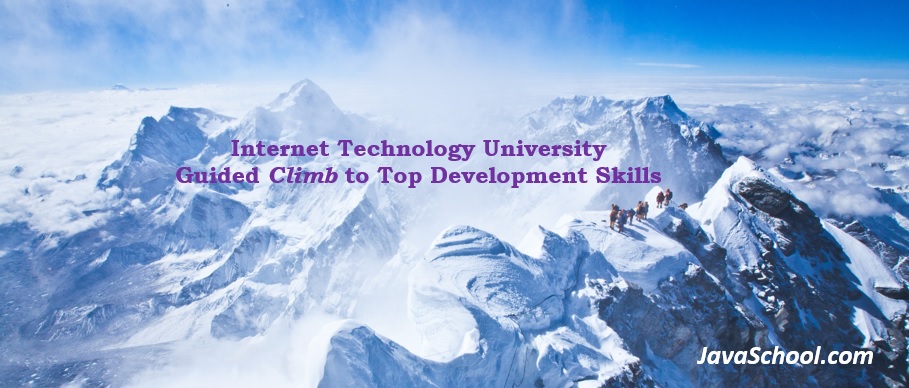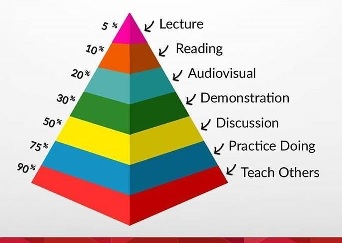What do we offer?
With all excitement related to the recent AI tools, like GPT-4, they are really just the tools.
We offer the platform and services to convert the tools into useful products for education and business.
The platform uses generative AI models such as OpenAI’s GPT-4, Google Gemini AI, Groq by Meta, and xAI Grok by Elon Musk
to accelerate decision making and knowledge sharing in education and business via conversational AI.
The solution can be deployed at your corporate facilities without any exposure of your data.
Background
A year salary for blue-color workers in the US is about six trillion dollars.
($6,000,000,000,000).
With all help from Google and more tools this is still a tremendous number.
How this was calculated: According to USA statistics
(
https://www.bls.gov/news.release/pdf/empsit.pdf)
about 160 million people are employed in that country.
About 70% are so called “knowledge workers” dealing with information daily with the average salary about $55k (
average-salary-information-for-us-workers)
their year salary is about $6 trillion.
Google is the best example in this market space. Google
is a universal engine providing hundreds links in response to every query,
helping everyone in a universal way and according to our estimate saving about
10% time, or about 600 billion dollars a year.
Big companies and startups are raising billions of dollars to employ AI in every area of business and consumer life.
ITU Offerring
Internet Technology University (ITU) focuses on Accelerated Sharing Knowledge with Conversational
Semantic Decision Support (AskCSDS) systems.
Our patented technology combines components of artificial intelligence with knowledge engineering expertise.
We develop methods and tools for building client-defined customized knowledge factories.
Almost every enterprise is looking for the ways to employ Artificial Intelligence and gain advantage or even dominance in their industry.
The wave of big and small development shops offering "AI development" cannot overcome the invisible barrier:
the enterprise is not ready, has no specific requirements on what to build.
Business Architecture Sandbox for Enterprise (BASE) is the implementation of the
Development Factory patent, a customizable AI engine.
This BASE AI platform takes advantage of the generative AI large language models such as OpenAI’s GPT-4, Google Gemini AI, and Grok AI by Tesla.
BASE can be installed behind the enterprise firewall or in the cloud to quickly build a customized knowledge factory for specific business to improve IT efficiency and to provide Conversational Semantic Decision Support.
By creating a knowledge domain for their business, enterprise greatly increases efficiency and might gain dominance in its industry.
Our business plan is to profit from licensed installation of the engine, BASE, and subscriptions for customization and maintenance.
How do we plan to use investments?
Quickly scaling up in the fresh market. Scaling up our marketing and consulting teams.
Improving user interface and functionality based on early feedback.
Custom Use Case Samples
Knowledge Delivery as a Service
The main scenario of Knowledge Delivery as a Service includes several customization steps:
The service engages a client into a conversation to define and refine daily the area of interest
The service uses corporate knowledge factory as well as publicly available sources to collect
defined by a client information as an Ontology
The service includes a semantic engine to retrieve meaningful information from many data layers.
The service effectively creates specialized knowledge domains in the client defined areas.
Greatly improving search, knowledge domains open more opportunities described below.
From capturing "Tribal Knowledge" to Conversational Design and Development Factory…
The conversational approach to knowledge acquisition combines the power of Big Data and Semantic Technologies with the human intuition
to create a Corporate Knowledge Factory as a base for Conversational Decision
Making Systems.
For example, the
Adaptive Robot System (US patent) can converse with a SME to
retrieve and translate “tribal knowledge” into rules, scenarios, and services.
This is a starting point for more ambitious use cases.
Integrated software and knowledge engineering leads to
truly collaborative (human-robot) development.
Client Benefits: Use Cases
1. Solving complex tasks by creating a unified landscape for all information systems
Companies have begun transitioning their IT to a cloud. We offer a transformation, which makes
transitioning to a cloud much more efficient and enables solving complex problems.
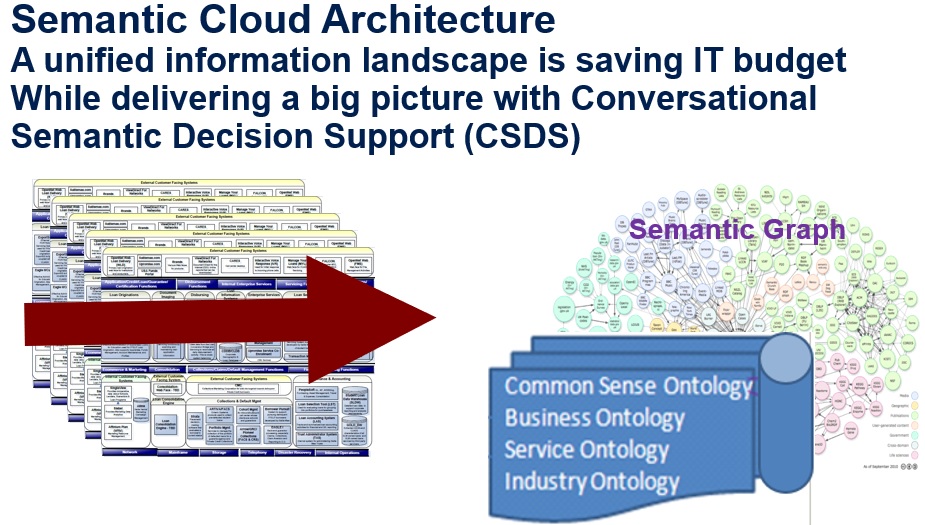
Historically, different types of information has been
processed by different systems because
Specific
data tables in
specific applications make
specific SQL queries
perform faster.
But in the increasingly interconnected business,
integration efforts outweigh the benefits of specific approaches to specific
data. And the growing art and science of Big Data helps us
understand a complete business story instead of having to piece it
together.
Smart cloud services collect enterprise
information in a unified knowledge component, corporate knowledge factory,
improving opportunity for automation, enabling solving previously not-solvable problems.
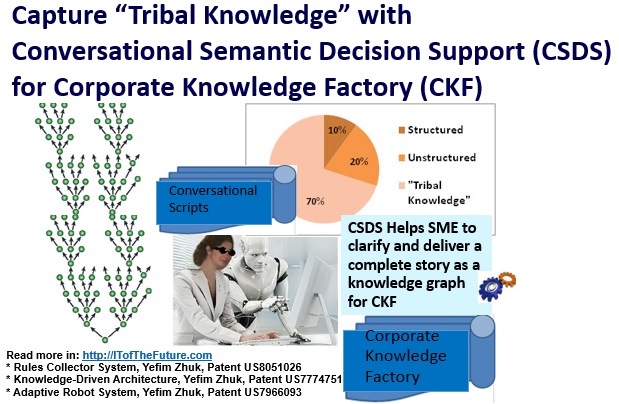 2. Increasing business efficiency and providing decisive advantage over similar businesses
2. Increasing business efficiency and providing decisive advantage over similar businesses
by integrating structured and unstructured data and collecting “tribal knowledge” in the corporate knowledge factory.
Every company is striving to become a leading business in its business area.
Companies invest in smarter people and smarter technology.
Smart cloud services offer an optimal combination of both.
Conversational Semantic Decision System (CSDS), described
in the patents
Knowledge-Driven Architecture and
Adaptive Robot Systems helps transforming multiple forms of information into a knowledge domain.
Multiple CSDS can collaborate with each other to connect knowledge branches.
CSDS can also converse with a SME to retrieve and translate “tribal knowledge”
into rules, scenarios, and services.
Conversational approach to knowledge acquisition combines the power of Big Data and Semantic
Technologies with the human intuition. This combination effectively creates a
Corporate Knowledge Factory as a base for Conversational Semantic Decision Support (CSDS) systems.
Integrated software and knowledge engineering leads to truly collaborative (human-computer) development.
Development life cycle with its multiple teams of business, development and maintenance teams will be replaced by Conversational Development and Manufacturing (CDM).
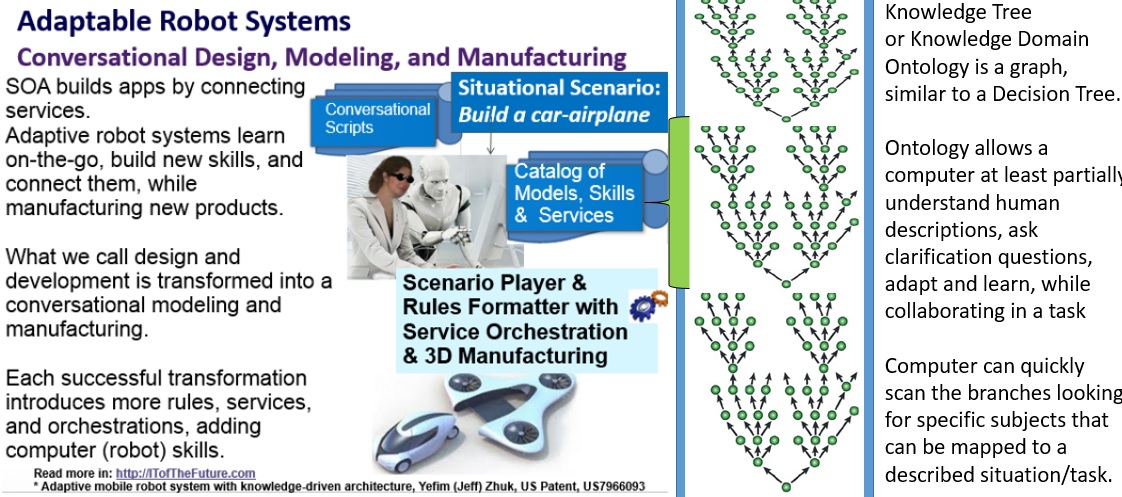
A powerful combination of human intuition and computer restlessness is expanded by the conversational approach. CDM uses ontology to map human instructions to the knowledge tree. CDM has access to corporate knowledge factory and also connected to related knowledge domains. These connections allows CDM to fill in “know how” - technical details, which may include corporate policies and regulations as well as business process instructions and usually consume most of development time.
An Adaptive Robot system is a sample of such a Development Factory.
Adaptive robot systems (US Patent 7966093) can learn on-the-go and build new skills, while providing on-the-fly translations of situational requirements into adaptive behavior models and further down to service scenarios for a collaborative robot team.
The use case expands on Service-Oriented Architecture. Orchestrated services are assembled into business scenarios and applications.
The invention integrated SOA with Knowledge Engineering to allow resolving new situations via computer-human collaboration. Built-in the system knowledge domain (ontology) helps a computer be a bit smarter by asking questions to refine instructions.
This invention is improving robot-to-robot and robot-to-human conversational interface and providing on-the-fly translations of situational requirements into adaptive behavior models and further down to service scenarios for a collaborative robot teams, effectively building new robotic/computer skills.
An example of such distributed collaborative work of robots and SMEs in conversational mode is provided below with a use case related to the military field.
On the image below, a subject matter expert sends the order "Clear Mine Field" to a robot system.
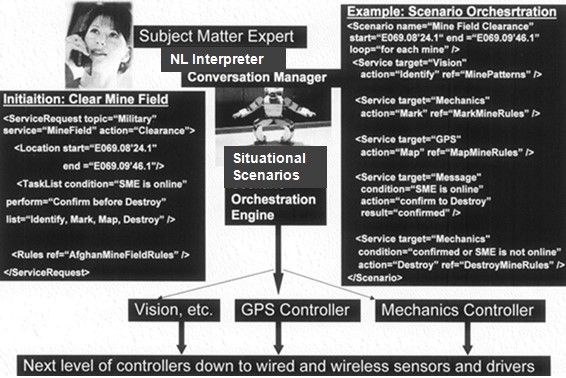
One or more robots, which is specialized in the Military operations, will intercept the order and subscribe as potential participants to this request. This will start a conversation between the system and the sender of the order. This conversation will result in a formatted scenario to be executed as a set of orchestrated services. The Conversation Manager will interact with the Scenario Formatter and check with the Service Dictionary to see if a scenario has been completed and can be executed.
The invention below patented in the US and 15 Europian countries transforms a beautiful idea of collaborative decision-making into a reality.

The
Development Factory patent describes the major points of Conversational Design and Manufacturing with AI components.
Client benefits will drive our company profit.
Clients will be able to increase business productivity by semi-automation in decision-making processes.
Estimated client benefit of using smart clouds is about 10% of their budget for knowledge workers (10% of $60 bln is $6 bln).
Our conservative estimate is that clients will pass about 3-5% of their benefit to pay for our help in AI customization efforts.
We plan to
initiate this work free for high visibility companies as our investment to gain name recognition.
Then this channel will generate constantly increasing revenue.
Allow common access to knowledge domains excluding client-specific knowledge branches
This will open an opportunity for advertising and add additional 10% to revenue.
3. Creating a new education paradigm will bring an additional revenue
Current Formula of Education:
- Colleges and Universities serve as the main channel to access education
- Graduates: have hard time finding work
- Current shift to remote education and training is conflicting with existing educational practices.
Internet Technology University (ITU) and Semantic Technology is changing the formula of education.
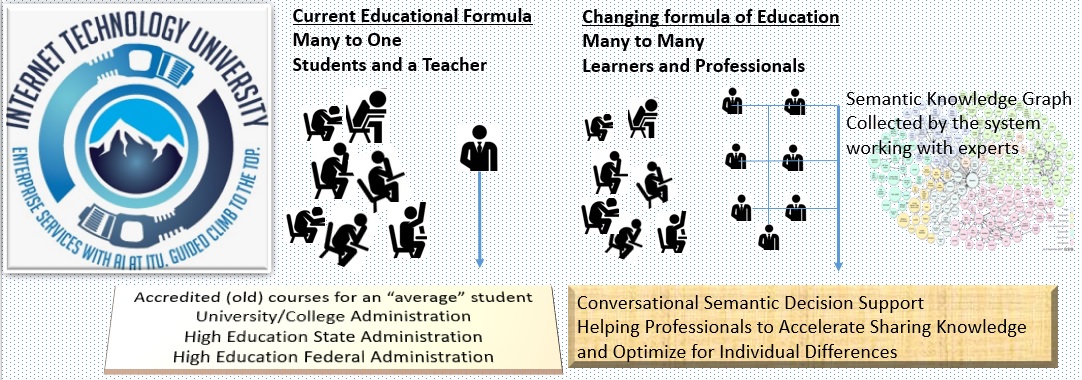
A Conversational Semantic Decision Support (see references and patents below) not only helps students by
optimizing Individual Learning Process.
CSDS also helps SMEs to transfer their knowledge into educational quality materials.
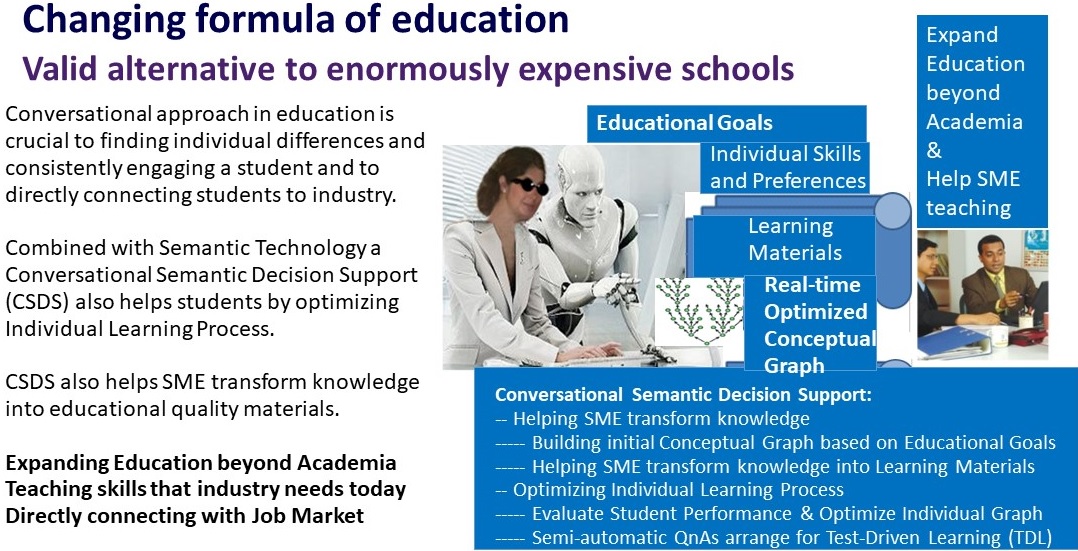
A new Educational Platform by ITU effectively Expands Education beyond Academy by helping SME, who wants to share, becoming a SME-instructor, teaching skills
that are needed today and tomorrow,
directly connecting students with Job
Market.
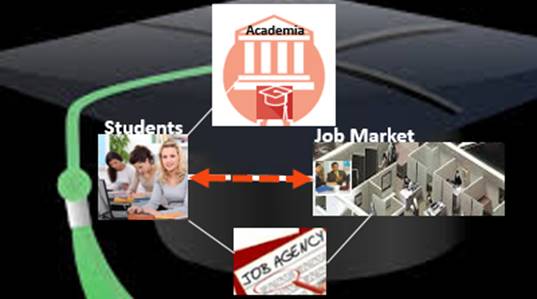 This will reduce the necessity for brokerage between a student and a profession.
This will reduce the necessity for brokerage between a student and a profession.
This is done in other industries. Smart applications such as Uber remove the necessity for brokers - receptionists at taxi stations. Smart applications directly connect consumers and producers.
Professional education will become less dependent on brokers, such as Academia and job agencies. Smart applications with CSDS will streamline professional education, directly connecting students and jobs.
Educational publishers will finally be in a position to grow Global Knowledge Marketplace and to offer templates (conversational scripts) helping authors, first of all the SMEs, to share their unique knowledge.
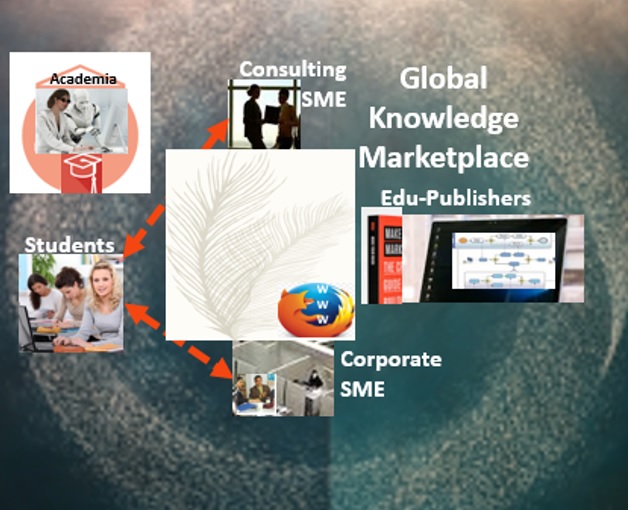 Consulting agencies
Consulting agencies, which often have the best SMEs in a specific knowledge domain, will become invaluable knowledge resources. The system/platform helps SMEs sharing their unique knowledge in multiple ways, including Teaching-by-samples, Test-driven-study, and more. Some of these ways, such as Test-driven-study can be used for screening potential candidates.
Some companies, such as IBM, Google, Facebook, already started this process. CSDS will make it efficient.
With our team of software and knowledge consultants we plan to bring additional 10% of revenue.
We plan to open our educational platform to IT and other selected industries and pay selected students and
SMEs to become instructors and marketing partners.
After initial investment, this program will become profitable, although we plan to keep low profit to continue growing.
Our goal is to shift gears in higher education towards companies, expanding education beyond Academy,
helping directly connect Job Market and students, greatly improving educational results.
This area of business started bringing significant attention from private and public organizations.
4. Creating Development Factory that significantly accelerates developing and manufacturing new products.
Traditionally, development and manufacturing engages multiple teams into multiple step processes.
The idea is usually initiated by a subject matter expert (SME), then more details are added by business analysts and developers who translate the idea into technology.
In each step of translation, such as system architecture, computer code development, or detailing parts for a new transportation mechanism, the next level of details is added by next level teams, who extensively interact with computers searching for relevant information.
This work is often supported by business process modeling systems.
The invention accelerates development and manufacturing processes by including conversational semantic support systems (CSSS) as active participants and partners of a SME in the process.
CSSS receives an initial request from SME, provides a mapping from business goals to existing business tasks, scripted rules and scenarios, automatically moving to the next step of details, when available.
The interesting things start when data is not available.
At this point the system initiates a set of conversations with other CSSS available on the net.
If data are not found, a program initiates a search over public and private data sources, over the Internet and available Data Clouds.
The last resort is a conversation with a set of SME connected to the net.
Retrieved and approved by SME data is registered while constantly increasing the knowledge of a system and its efficiency.
Questions and Answers:
What is the actual goal and problem space you are looking to address?
The goal is trivial although the solution is not.
The goal is to let computers do things that are mostly tedious operations, but today are performed by people.
We often call these people “knowledge workers” as they operate with information.
This work can be more automated, saving trillions of dollars.
To enter this market means to teach computers to understand more and to help more.
Why your solution? Are there others in this problem space? What differentiates you from others?
There are three major solutions in this space.
All three solutions help computers understand more and help more.
a) Generic search by Google – helps all "knowledge workers" regardless of their profession
search and find information on the web via entering related keywords. This
saves about 10% of time/budget, which is about $600 billion dollars (a total
market is about $6 trillion dollars).
b) Engaging knowledge engineering consultants to create specific
knowledge domain ontologies by using Semantic Tools, such and
AllegroGraph, TopBraid, OntoText and similar.
- Creating Ontology is a very hard task, which requires both
domain expertise and knowledge engineering expertise. Plus it is a very time
consuming task. These challenges limit success of this movement and these tools
to about 0.5% of market.
c) Cognitive computing, when we throw data in the computer,
giving a good algorithm and a chance to figure out what is these data about and
find data patterns for analysis.
- This is a relatively new technology, like IBM Watson, which has
a long way for success.
- The biggest challenge is what to do with the patterns found?
Computers, while looking for patterns, currently is not aware about business
goals and specific applications where these patterns can apply.
- Overtime, I expect cognitive computing to be integrated with the
conversational approach described in several patents.
Our solution combines computer restlessness with a domain expert
intuition via conversational interface. It is a system and methodology, which includes
components described before and adds a conversational mechanism
to better connect SMEs, ontology, and a computer programs.
Is your solution a better way?
Our solution, which is protected by several patents,
combines computer restlessness with a domain expert intuition via conversational approach.
The AI engine, BASE (Business Architecture Sandbox for Enterprise),
is highly a customizable ready-to-go playground helping any (or almost any) enterprise to quickly find the best way AI can help in their specific business.
The main steps are illustrated below.
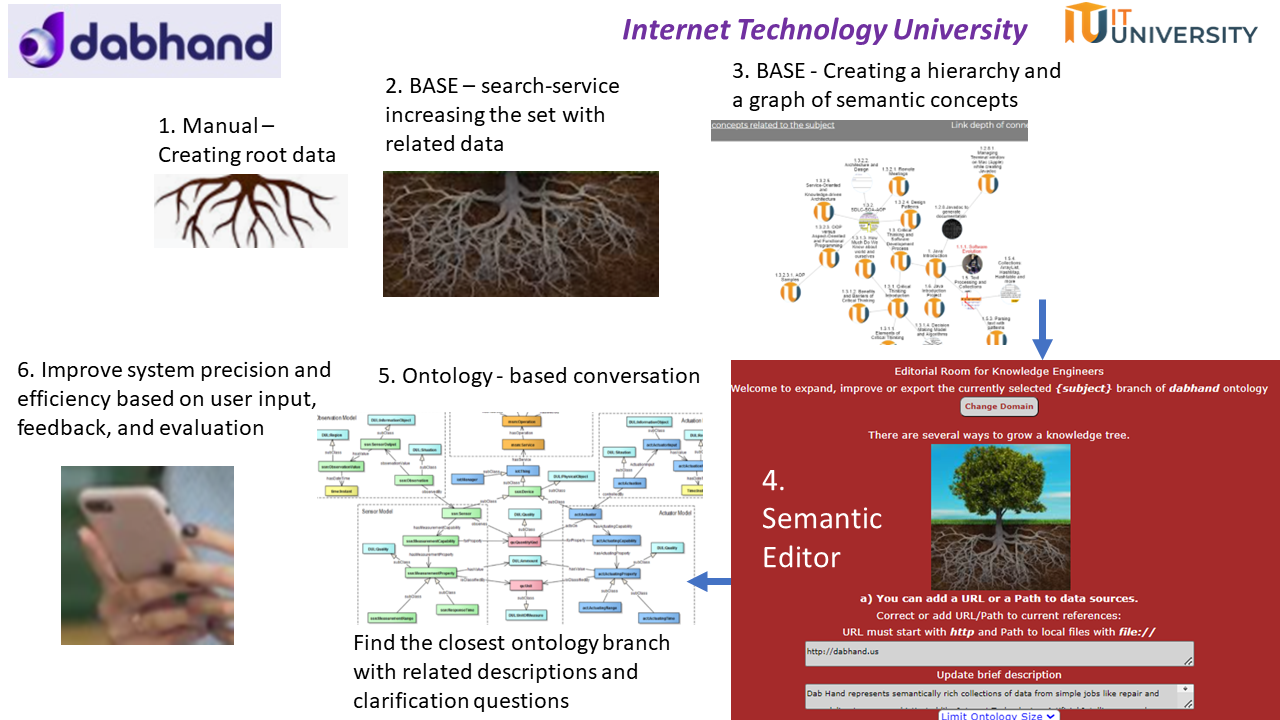
Each interaction with users enhance the conversational scripts, grow
knowledge domain ontology and makes more precise definition for collecting data
from public sources, which in its own turn improves ontology.
Growing Ontology allows business users to gain immediate advantages in their business processes.
There are several companies and products, such as Open AI with ChatGPT, that describe similar ideas.
Our advantage:
a) The BASE is placed behind your firewall, so no need to send your business data outside.
b) Our system is protected by a set of patents, including the "Development Factory",
which provides conversational design, manufacturing, and marketing of products and services.
What is the technology, in regular laymen terms?
Is this a form of AI, a new methodology or both?
- It is more a system and methodology that uses conversational AI and supervised machine learning.
Do you have a working prototype? Does it clearly demonstrate the technology?
Yes, we have a working system, a highly customizable AI engine, Business Architecture Sandbox for Enterprise (BASE) described in the book
http://ITofTheFuture.com and protected by patents.
BASE serves as a playground for new technologies that use conversational AI.
The Mobile Apps "Dabhand" is our first specific product focusing on a specific industry.
Internet Technology University (https://ituniversity.us) is our web-based system focusing on education.
More companies in different industries are looking for the ways to employ AI.
Customizing BASE and helping these companies to greatly benefit from existing corporate knowledge is a very profitable business.
Feel free to ask more questions...
Jeff (Yefim) Zhuk | 720-299-4701 |
jeff.zhuk@captureknowledge.org |
http://ITUniversity.us |
Dabhand
